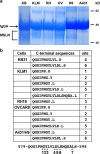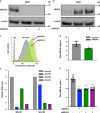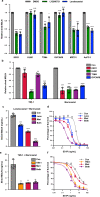Multiple proteases are involved in mesothelin shedding by cancer cells
- PMID: 33262421
- PMCID: PMC7708464
- DOI: 10.1038/s42003-020-01464-5
Multiple proteases are involved in mesothelin shedding by cancer cells
Abstract
Mesothelin (MSLN) is a lineage restricted cell surface protein expressed in about 30% of human cancers and high MSLN expression is associated with poor survival in several different cancers. The restricted expression of MSLN in normal tissue and its frequent expression in cancers make MSLN an excellent target for antibody-based therapies. Many clinical trials with agents targeting MSLN have been carried out but to date none of these agents have produced enough responses to obtain FDA approval. MSLN shedding is an important factor that may contribute to the failure of these therapies, because shed MSLN acts as a decoy receptor and allows release of antibodies bound to cell-surface MSLN. We have investigated the mechanism of shedding and show here that members of the ADAM, MMP and BACE families of proteases all participate in shedding, that more than one protease can produce shedding in the same cell, and that inhibition of shedding greatly enhances killing of cells by an immunotoxin targeting MSLN. Our data indicates that controlling MSLN shedding could greatly increase the activity of therapies that target MSLN.
Conflict of interest statement
I.P. has patents to immunotoxins targeting mesothelin that have all been assigned to NIH. All other authors declare no competing interests.
Figures






Similar articles
-
Reduced Shedding of Surface Mesothelin Improves Efficacy of Mesothelin-Targeting Recombinant Immunotoxins.Mol Cancer Ther. 2016 Jul;15(7):1648-55. doi: 10.1158/1535-7163.MCT-15-0863. Epub 2016 May 18. Mol Cancer Ther. 2016. PMID: 27196771 Free PMC article.
-
Tumor resistance to anti-mesothelin CAR-T cells caused by binding to shed mesothelin is overcome by targeting a juxtamembrane epitope.Proc Natl Acad Sci U S A. 2024 Jan 23;121(4):e2317283121. doi: 10.1073/pnas.2317283121. Epub 2024 Jan 16. Proc Natl Acad Sci U S A. 2024. PMID: 38227666 Free PMC article.
-
Cytotoxic activity of immunotoxin SS1P is modulated by TACE-dependent mesothelin shedding.Cancer Res. 2011 Sep 1;71(17):5915-22. doi: 10.1158/0008-5472.CAN-11-0466. Epub 2011 Jul 20. Cancer Res. 2011. PMID: 21775520 Free PMC article.
-
Mesothelin-Targeted Recombinant Immunotoxins for Solid Tumors.Biomolecules. 2020 Jun 28;10(7):973. doi: 10.3390/biom10070973. Biomolecules. 2020. PMID: 32605175 Free PMC article. Review.
-
Immunotherapy targeting mesothelin in acute myeloid leukemia.J Leukoc Biol. 2022 Oct;112(4):813-821. doi: 10.1002/JLB.5MR0622-483R. Epub 2022 Aug 10. J Leukoc Biol. 2022. PMID: 35946307 Review.
Cited by
-
Enhancing mesothelin CAR T cell therapy for pancreatic cancer with an oncolytic herpes virus boosting CAR target antigen expression.Cancer Immunol Immunother. 2025 May 14;74(7):202. doi: 10.1007/s00262-025-04039-7. Cancer Immunol Immunother. 2025. PMID: 40366419 Free PMC article.
-
Low serum mesothelin in pancreatic cancer patients results from retention of shed mesothelin in the tumor microenvironment.Transl Oncol. 2022 Jul;21:101440. doi: 10.1016/j.tranon.2022.101440. Epub 2022 May 4. Transl Oncol. 2022. PMID: 35523008 Free PMC article.
-
Excess shed mesothelin disrupts pancreatic cancer cell clustering to impair peritoneal colonization.FASEB J. 2024 Dec 13;38(24):e70247. doi: 10.1096/fj.202400446R. FASEB J. 2024. PMID: 39673668 Free PMC article.
-
Mesothelin: An Immunotherapeutic Target beyond Solid Tumors.Cancers (Basel). 2022 Mar 18;14(6):1550. doi: 10.3390/cancers14061550. Cancers (Basel). 2022. PMID: 35326701 Free PMC article. Review.
-
Potent and durable control of mesothelin-expressing tumors by a novel T cell-secreted bi-specific engager.J Immunother Cancer. 2025 Mar 13;13(3):e010063. doi: 10.1136/jitc-2024-010063. J Immunother Cancer. 2025. PMID: 40081946 Free PMC article.
References
-
- Morello A, Sadelain M, Adusumilli PS. Mesothelin-targeted CARs: driving T cells to solid tumors. Cancer Discov. 2016;6:133–146. doi: 10.1158/2159-8290.CD-15-0583. - DOI - PMC - PubMed
Publication types
MeSH terms
Substances
LinkOut - more resources
Full Text Sources
Medical
Miscellaneous

